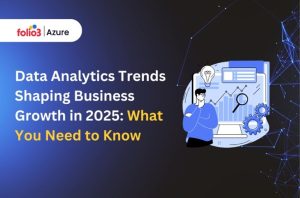Table of Contents
ToggleIn a world where data reigns supreme, the effective visualization of information is paramount for making the right decisions. Custom dashboards have become the epitome of smart data management, painting a comprehensive picture of pertinent metrics and KPIs at a glance.
- What is a custom dashboard?
- Why are custom dashboards in demand more than the traditional ones?
- What are the key components of an effective custom dashboard?
- What steps can one follow to build their custom dashboard?
- What are folio3 Azure services and why might someone need them for custom dashboard creation?
- What pitfalls should be aware of in customer dashboards?
This post will usher you through the intricacies of building custom dashboards that not only aggregate data but also tell a story that any stakeholder, from the C-suite to the sales floor, can understand and act upon.
The Power of Data Visualization in Decision Making
The true power of data visualization lies in its ability to simplify complexity. A well-crafted visualization can take a dense data set and transform it into a narrative that’s easy to understand. This can be vital for decision-makers who may not have the time or expertise to parse raw data.
For instance, a line chart showcasing sales trends over time can immediately highlight peaks and troughs, signaling the need for further investigation. The intuitive nature of visual data representation makes it an indispensable part of the decision-making process across all industries.
Benefits of Data Visualization
Good data visualization offers various benefits:
- It capitalizes on the brain’s natural inclination to process visual information swiftly, aiding in quick insights extraction.
- Enhanced memorability and shareability of information are achieved through visual representations.
- It facilitates collaborative decision-making
- Visual data transcends language barriers, enabling diverse teams to align on strategies effectively.
- Overcomes technical jargon obstacles, fostering efficient goal alignment among team members.
- Tailored visualizations cater to users’ specific needs and preferences.
- Personalized data interpretation enhances decision-making processes, ensuring optimal understanding and utilization.
Understanding the Basics Before You Start
Before you start building your custom dashboard, it’s critical to grasp some foundational principles.
Clarity, Consistency, and Accessibility:
These are the pillars of an effective dashboard design. Clarity ensures that the information displayed is immediately comprehensible, while consistency fosters a user-friendly experience. Accessibility, both in terms of the design and technology used, ensures that the dashboard can be utilized by all intended viewers.
Setting Clear Objectives for Your Dashboard:
Your custom dashboard should have a clear purpose. It’s not just about looking good; it’s about providing the right information at the right time to facilitate actions that align with strategic goals.
Planning and Designing Your Custom Dashboard
Designing a dashboard begins with knowing what you want to achieve. Start by setting clear objectives, identifying the audience, and defining the KPIs that matter the most. Next, plan the layout and select the appropriate visualizations that will best represent your data and insights.
Different Types of Dashboards
Below are the different types of dashboards:
1. Operational Dashboards
Operational dashboards provide real-time tracking of performance and operations. Ideal for day-to-day monitoring, they help manage immediate workflows and short-term performance, alerting teams to issues as they arise and enabling quick responses.
2. Analytical Dashboards
Analytical dashboards are designed for in-depth analysis and strategic decision-making. They integrate large sets of data from various sources, offering historical insights and trend analysis. This type of dashboard is best suited for managers and analysts focused on longer-term strategies.
3. Strategic Dashboards
Strategic dashboards give a high-level view of an organization’s overall health and strategic objectives. They focus on long-term goals and key performance indicators (KPIs), providing executives and senior leadership with the information needed to make broad strategic decisions.
4. Tactical Dashboards
Tactical dashboards bridge the gap between operational and strategic dashboards. They focus on medium-term objectives and department-level performance, helping managers to track progress towards specific goals and adjust tactics accordingly.
Selecting the Appropriate Visualization Tools
The market is brimming with tools that offer a diverse range of visualization options. Understand the dataset and the story you want to tell to choose the tools wisely.
1. PowerBI
PowerBI is a robust data visualization tool provided by Microsoft. It’s especially renowned for its deep integration with other Microsoft products, making it a go-to solution for businesses already embedded within the Microsoft ecosystem.
PowerBI excels in creating comprehensive dashboards and interactive reports that facilitate data-driven decision-making. Its user-friendly interface, alongside the capability to handle large datasets efficiently, allows both novices and experts to derive valuable insights with relative ease.
2. Tableau
Tableau stands out for its intuitive interface and powerful analytics capabilities that support the creation of visually appealing and interactive dashboards. It excels at transforming large volumes of data into actionable insights, catering to users across various skill levels.
Tableau’s strong community and extensive resources further enhance its appeal, making it a preferred choice for those seeking to tell compelling data stories without a steep learning curve.
3. Qlik
Qlik, with its unique associative analytics engine, offers a different approach to data exploration and visualization. It supports both guided analytics for business users and developer-friendly environments for more bespoke applications.
Qlik’s in-memory data processing capabilities ensure fast responses to queries, enabling real-time data analysis. This tool is particularly valued for its ability to uncover hidden trends and patterns, thereby providing users with comprehensive insights.
4. Looker
Looker, part of Google Cloud, emphasizes customizable data exploration and operates on a powerful in-database architecture. It enables businesses to extract, visualize, and analyze data directly from their database, promoting a single source of truth across the organization.
Looker’s model is based on the LookML language, which allows for the creation of highly reusable and easily maintainable data models. Its strength lies in its ability to integrate seamlessly with other data analysis tools and platforms, offering flexible solutions for complex data scenarios.
Creating Cohesive Data Storytelling
The ultimate goal of a dashboard is to tell a compelling story with data. Every visualization should have a purpose in that story, leading to actionable insights. This includes everything from color schemes and font sizes to the inclusion of interactivity features like drill-downs and filters. A well-designed dashboard invites exploration and inquiry.
Building Your Custom Dashboard
The technical aspect of dashboard building is executing the plan you’ve devised. This involves integrating the necessary data sources, leveraging visualization tools, and implementing interactivity features that make the dashboard not just informative, but engaging.
Tools and Technologies for Dashboard Creation: Familiarize yourself with the leading dashboard software programs and the technologies they leverage. Each has its strengths and nuances, so it’s important to select one that aligns with your team’s expertise and your organization’s infrastructure.
Integrating Data Sources: The accuracy and timeliness of your data are non-negotiable. Invest the time in ensuring that your dashboard pulls from reliable sources and that updates happen seamlessly and reliably. Automated data integration tools can help simplify this process, reducing manual effort and minimizing the risk of errors.
Visualizing Data: Consider the type of data you are working with when choosing visualization methods. Line charts, bar graphs, and pie charts are all commonly used types of visualizations but may not be suitable for every dataset. Experiment with different types to find the most effective way
Implementing Interactivity and Customization Features: Users should be able to manipulate the dashboard to view data from different angles. The ease and intuitiveness of this user experience will be a major factor in the dashboard’s usefulness.
Testing and Iterating Your Dashboard
A dashboard is never truly complete. It must evolve with the business and user needs. The testing and iteration phase is where you learn how your dashboard serves its purpose and where it falls short.
Conducting User Testing and Gathering Feedback:
User experience is paramount. Collect feedback from stakeholders on the dashboard’s usefulness and ease of use. This can include focus groups, surveys, and one-on-one interviews. Analyze the feedback and decide on improvements.
You may need to tweak visualizations, enhance performance, or add new features. The iterative process leads to a final product that meets the needs of the organization.
Deploying and Maintaining Your Dashboard
Deploying a dashboard involves making it accessible to users while maintaining it involves ensuring continued relevance and performance.
Best Practices for Dashboard Deployment:
Deploy in a way that doesn’t compromise the dashboard’s performance, especially as user numbers grow. Scalability is key. Consider access restrictions to sensitive data and user permissions. Regularly monitor usage statistics and collect feedback.
Maintaining Your Dashboard:
Maintaining your dashboard involves regularly reviewing its performance, ensuring data accuracy, and implementing necessary updates. This process may involve collaboration with IT teams to ensure the dashboard is secure and compliant with company policies. It’s also important to regularly reassess the usefulness.
Encouraging a Data-Driven Culture
A custom dashboard is more than a collection of visual elements. It’s a tool to promote a data-driven culture within an organization. When employees from all levels can access, understand, and act on data, it fosters a more informed and empowered workforce.
Building a custom dashboard is as much an art as a science. It requires a deep understanding of the data, the audience, and the strategic objectives of the organization. It can be a complex and time-consuming process, but the rewards in terms of enhanced decision-making and performance can be immense.
If you’re considering creating a custom dashboard, we invite you to explore the services we offer at folio3 Azure. Our expertise in data visualization and dashboard creation can be a valuable asset in your quest to transform raw data into actionable insights.
Remember, the dashboard is a direct reflection of your data story—a well-told one can revolutionize your organization’s approach to data.


